When we first started planning this trip, 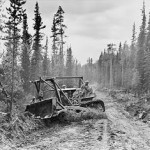 I had visions of myself, my wife, and 10 other people pushing our Toyota Motor home through mud bogs, being towed by a bulldozer, bugs, animals cold, heat, etc, etc, etc..
I had visions of myself, my wife, and 10 other people pushing our Toyota Motor home through mud bogs, being towed by a bulldozer, bugs, animals cold, heat, etc, etc, etc..
We were warned to take extra spare tires, gallons of gas cans, extra tools, spare parts. The roads were mud and there were hundreds of miles between any services.
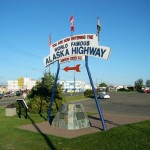 We’ll, I’m here to tell you, this is not your fathers Alaska Highway.
We’ll, I’m here to tell you, this is not your fathers Alaska Highway.
Although the current Alaska Highway wouldn’t compare to a modern 4 lane Interstate Highway in the lower 48, it’ll certainly meet the same standards as most rural roads in the US, and traveling it will be for the most part, just as uneventful.
The Road
Since the Alaska Highway (the Alcan) first opened , it’s been constantly upgraded and improved. 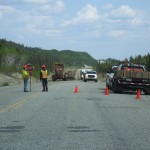 Today’s highway runs the same basic route, but for the most part, the curves have been straightened, the hills have been leveled, the road surface has been paved, and the easements have been widened.
Today’s highway runs the same basic route, but for the most part, the curves have been straightened, the hills have been leveled, the road surface has been paved, and the easements have been widened.
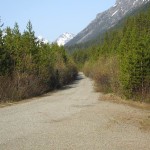 In many locations along the route, you can see the old unused original road as it meanders back and forth, up and down, and on occasion, you’ll find a short section that you can actually drive on.
In many locations along the route, you can see the old unused original road as it meanders back and forth, up and down, and on occasion, you’ll find a short section that you can actually drive on.
The highway is maintained year round and in good condition. However, the farther north you go, frost heaves are a constant maintenance issue and can do severe damage to any vehicle.
Prepare your vehicle
You’re going to see 18 wheeler, motorhomes, and passenger vehicles making the trek.
Any vehicle that’s in good mechanical condition is worthy of the trip up the Alcan. If you’d fell comfortable driving your vehicle coast to coast in the lower 48, then it should be OK on the Alcan, with a couple additional preparations.
1) Tires – Make sure the tires are in good condition, good tread, good sidewall (no cracking) and just as important, tire age. You can find the date code on the side of the tire, think seriously of new tires, including the spare if they are over 6 years old. I’d venture a guess that the vast majority of tire failures on the Alcan are older tires, that have good tread, and the sidewalls have failed.
2) Spare – The spare tire should be just as good as the tires on the road. Do not rely on a donut spare, find a full spare and rim.
IMPORTANT – Mount your spare tire on one of the wheels. This will verify that the jack works, the spare fits, and you know how to do it. Although AAA, Good Sam, or any of the road service companies will come out and change your flat, it could take a day for you to get to a phone to call them, and another day for them to get to you.
3) Fuel – More importantly, vehicle range. You shouldn’t have any problems in the summer, but spring, fall and especially winter, fuel stops along the Alcan may be closed OR (even during the summer) they may be out of fuel.
Always carry an extra 5 gallons of fuel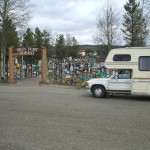 .
.
WORD OF WARNING – GAS CANS – Several years ago, the EPA mandated changes to gas cans, specifically, how the spout works. THESE NEW STYLE CANS SUCK – We found that in one of the cans we had, the spout wasn’t long enough to reach inside the gas filler neck, basically rendering the can (and the fuel it contained) useless. We also found the larger can, we couldn’t tip it far enough to get all the gas out, so we could only get about 3 gallons out of the 5 gallon can. We want to thank the Government for taking a gas can that worked perfectly, and modifying it into some piece of crap that’s useless.
JOHN’S SOLUTION TO EPA GAS CANS – BUY A LONG FUNNEL – If you need to use your gas can, just take the “Government Approved” spout off, place the funnel in your cars gas filler neck, and pour fuel directly out of the can into the funnel. If your careful, you won’t spill any, and you’ll be able to empty the entire contents of the can into your tank.
*** END OF VERY POed RANT
My Class C Toyota motorhome has a range of about 200 miles (17 gallons), I carry an extra 12 gallons of fuel, worst case, added an additional 120 miles (ALWAYS think worst case when planning gas mileage)
You may run into a situation that you were relying on a fuel stop, only to find their generator is broke (Yup, we had this happen), and they can’t pump fuel, OR, they may be out of fuel. Yup, had this happen also, OR, they may be closed.
ALSO – You may run across someone who needs your help.
Plan your fuel carefully and with plenty of reserve. you’ll be traveling into areas where you’ll go 100 plus miles without seeing another human being, vehicle, roadside business, let alone fuel stops.
NOTE – In several of the remote businesses, they run their own generators to make their electricity. If their generator breaks, They may have fuel in their tanks, but no way to pump it. We ran into this on one leg, fortunately, we carry extra fuel.
Plan your trip
If you’re just traveling to Alaska but not a tourist, any good Road Atlas that covers Canada will do.
Regardless if your a tourist or not, I recommend MilePost as a source for travel and planning. It has very extensive maps and details, not just the Alaska Highway, but routes from the lower 48, and routes / highways in Canada and Alaska other than the Alaska Highway.
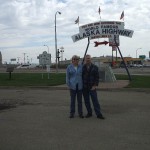 As you enter the Alaska Highway in Dalton Creek, you’re going to want to stop and take your picture at the famous “Alaska Highway” sign.
As you enter the Alaska Highway in Dalton Creek, you’re going to want to stop and take your picture at the famous “Alaska Highway” sign.
While you’re at the famous sign, stop at the visitor center. Its not the large building next to the sign (that’s a museum/gallery, I think) the Visitor Center is a small building next door to that. Go into the Visitor Center, look around, specifically ask for the “fuel and campground sheet”. As we traveled up the Highway, we referred to the information sheet regarding who had what services for our stops along the way. (i.e. Who has WiFi)
We also found those small booklets that cover individual cities, i.e. “Whitehorse”, “Dalton Creek”, Valdez”, etc, to be very helpful for information. The folks at the Information Center were very helpful in loading us up with information, AND – Don’t forget to ask about current road conditions, they have a sheet that reports road conditions, and its updated daily.
Overnight Accommodations
Many businesses along the Highway close down for the winter season (1 Oct – 31 May). HOWEVER- Regardless of when you travel, you need to plan ahead. This applies the same if your looking for a hotel room or a place to pull over and park for the night.
Your not going to find a Motel 6 or Holiday Inn along the route. Most (if not all) of the businesses are small family owned, and serve multiple functions (Hotel, restaurant, RV park, Gift shop, Post office, General Store, Barber shop, all under one roof.
ALSO – Always be prepared to spend a night in your vehicle, even in the summer. A mechanical breakdown or other unfortunate event could lead you spend the night in the Toyota Hilton. Be prepared, blanket, water, snacks
If you plan on spending your nights in the Hotel, call ahead and ask, Do you have rooms? What time do you close (late checkin)? Hotel or Reserved accommodations obviously require more planning than a random “Lets stop here” approach. Have a backup plan in case the Hotel or reservations don’t work out.
Modern Communications
Cell Phone, GPS, Internet.
Cell phone coverage is limited to the larger towns along the Highway (i.e. Whitehorse). Don’t plan on reliable coverage. If you have a U.S. provider, check with them regarding coverage in Canada. If you have a smart phone, don’t forget to ask about the Data Plan. In our case, our provider (Verizon) would charge 0.90 per minute roaming, and we don’t even want to talk about Data (Something like 0.10 per megabyte). Our solution was to turn the cell phones OFF as we entered Canada, and to use it only in an emergency if we needed to call out. We advised all our friends that the best way to get hold of us was via e-mail.
Once in Alaska, coverage gets better around the major metro areas. On a sour note, our provider (Verizon) doesn’t “own” any equipment in Alaska, but has some type of share agreement with the Alaska company. We had good reliable voice coverage, but found that our data plan would bandwidth throttle, and after a couple megs, would drop to zero bandwidth.. I was able to update this blog, load maybe 5 small photos, and then the connection speed started taking a dump. We discovered a work around – Turn the phone off, reboot the phone to pick up new IP address, and we would be good for another few megs of bandwidth.
WiFi – Internet Access
If you look around in the towns, you can always seem to find a hot spot. Be careful, you never know who/what the people are who made this hot spot available. I never do any credit card or other forms of transactions that involve my personal data over the free hot spots. Practice internet security, especially when its a free / unsecured WiFi / hot spot.
Most of the hotels and RV camps have a secure WiFi. Check ahead as some of the remote stops may not have phone, WiFi, coverage.
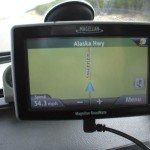 GPS – We used our GPS to find rest areas, camp grounds, hotels. Two caveats, GPS maps and information is dated and may not be accurate. GPS coverage is good, but occasionally we seen weird things that we believe may be GPS signal blocked or bouncing in the mountains. i.e., GPS shows the road about 500 ft to our left.
GPS – We used our GPS to find rest areas, camp grounds, hotels. Two caveats, GPS maps and information is dated and may not be accurate. GPS coverage is good, but occasionally we seen weird things that we believe may be GPS signal blocked or bouncing in the mountains. i.e., GPS shows the road about 500 ft to our left.
Our Travels
We traveled the Highway in a 1988 Toyota Class C RV that was in very good condition.
We planned on driving over 10,000 miles on our trip, so we went through the RV and made sure all the maintenance was up to date.
New radiator/coolant hoses, new belts, new filters (fuel, oil, transmission). Flushed the radiator and transmission. Repacked the wheel bearings (front and rear). Inspected the brakes (front and rear). Installed a new water pump, full lube job, check lubricant in rear axle.
The original tires on the RV had good tread, but were all 15 years old and if I looked carefully, could see cracking on the sidewalls. We replaced all 7 tires (6 and the spare) and even bought a extra rim and mounted the best old tire on it. That was our extra spare tire, and we didn’t need to use them.
Most of all, take your time, stop frequently and take in the views, and build some fantastic memories.
John & Jodie

Your documentation seemed to cover most of the items that I’ve been thinking about. I plan to do the route in the summer of 2018. I plan to install an additional 45 gallon tank for diesel. I will also be purchasing a generator to power some of the options in my 5th wheel (42′). One thing that I don’t remember seeing was the temperature during your trip. Obviously, the farther north that you drive, the cooler it may be. I am also thinking about a grill guard for the front of my Silverado K3500. How many RV’s traveled in your convoy? So, what other hardware am I forgetting?
David, we traveled right before Memorial Day. That’s kind of the start of their tourist season, so a lot of places weren’t open yet or were just getting ready to open. I believe we seen temperatures of 80-85 in Fairbanks.
We traveled alone and were not part of a group.
I was amused about your rant about the gas cans. Believe it or not, a year or so ago, there was an article in the local newspaper (The State News) about a small law firm here in Lexington that was instrumental in putting the maker (Blitz) of sane gas cans out of business through their continued suits against them in burn cases. I believe that most burn cases occur through the negligence (read: hot engines) of the user, but I digress. Since I could not find a replacement canwhen I was looking for it, the article enlightened me as to why. The new can that I had to buy is unworkable and I have never been able to get gasoline out of it through the “new and improved” spout. This causes me to have to remove the spout and pour the gasoline from the lip through a funnel, which is far more hazardous than the Blitz. It prompted me to write a letter to the paper offering myself as a plaintiff in the next lawsuit as a result of being burned up by the unuseable new spout.
by the way thanks for your response to my FR Forum question
We will be making the trip starting in May 2017 and leaving from Yuma Arizona going up into Washington and crossing their plan on spending the entire summer there anyone interested in the trip let me know